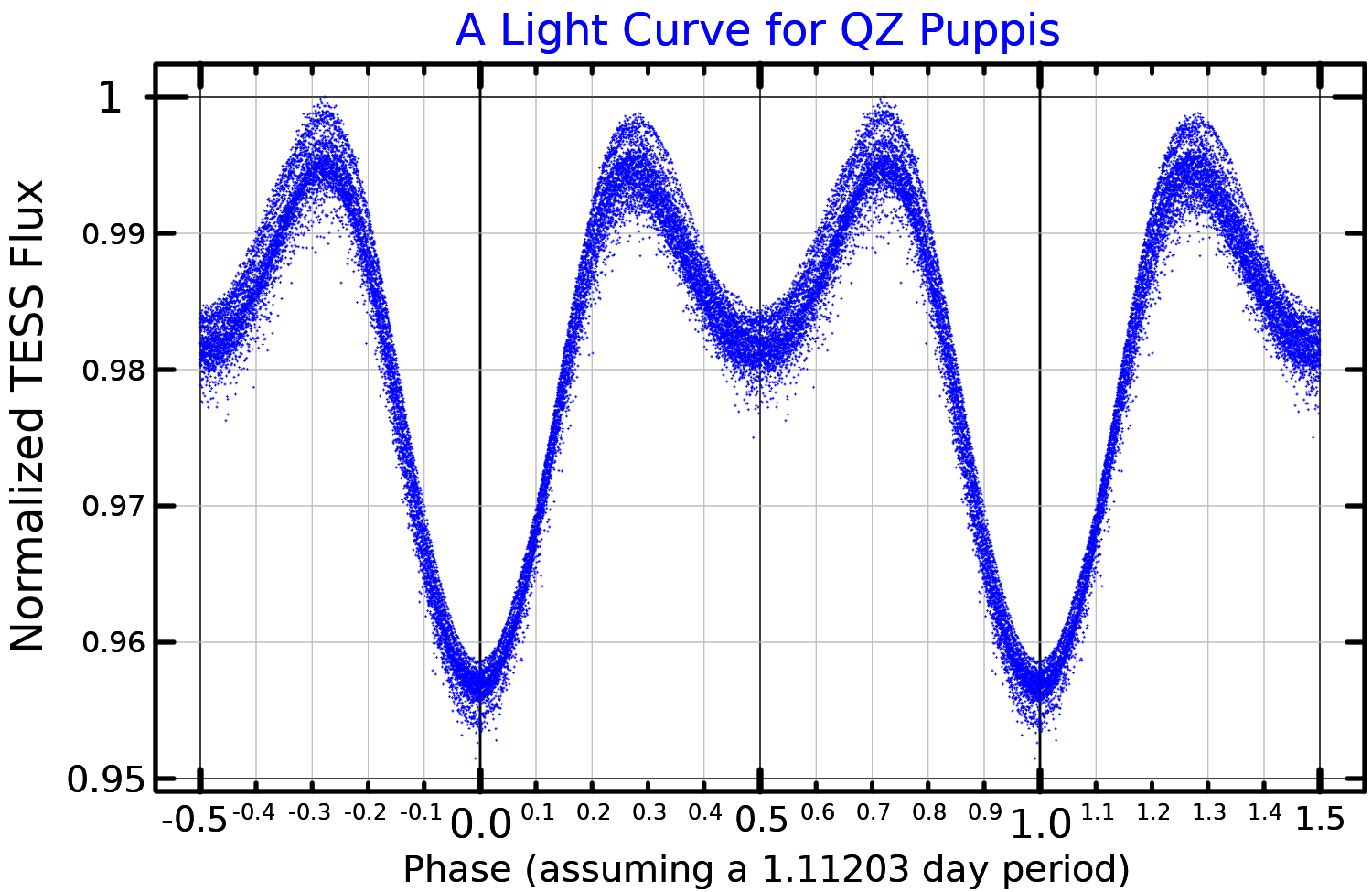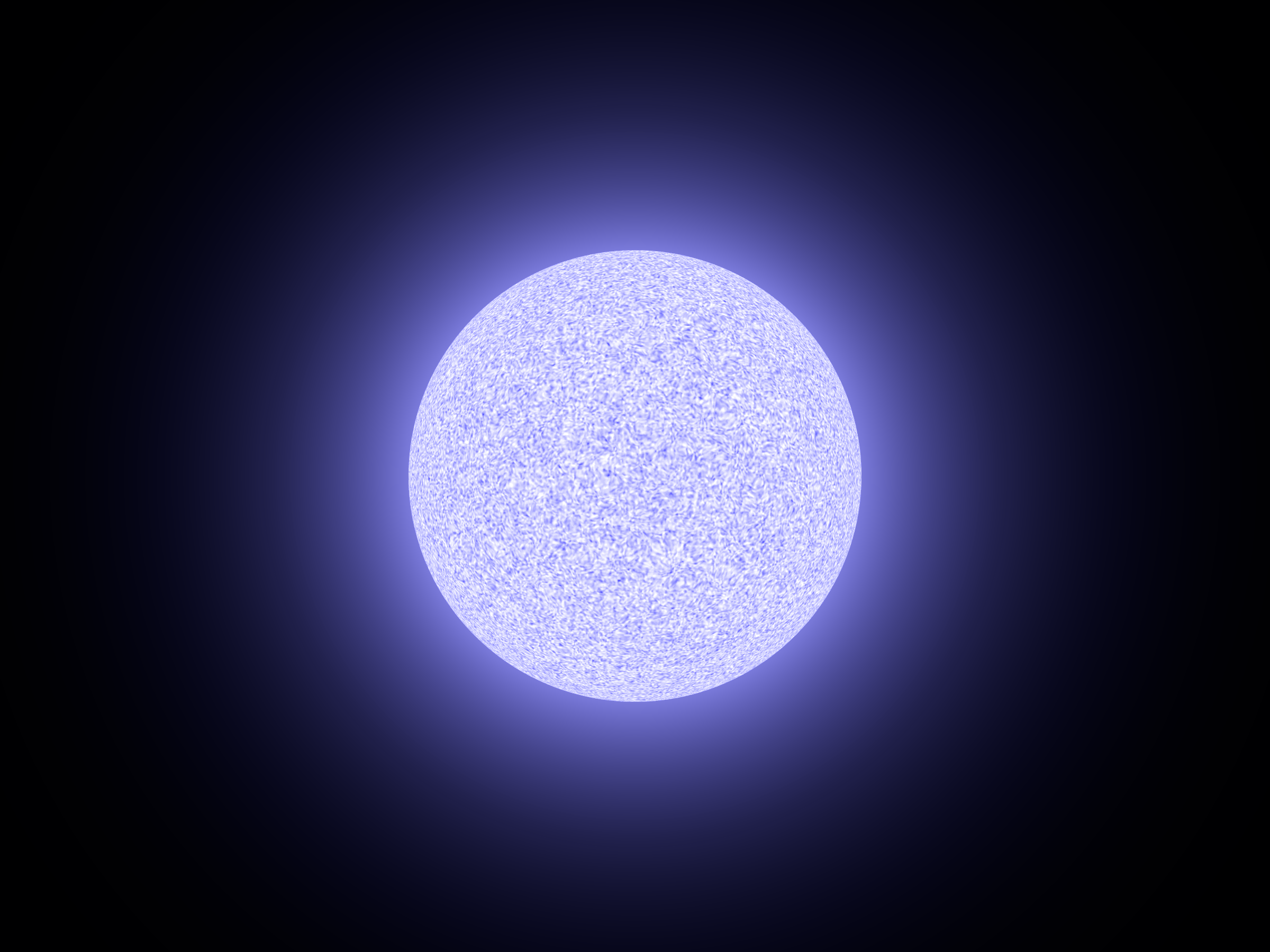|
QZ Puppis
QZ Puppis (QZ Pup, b Pup) is a class B2.5V (blue main-sequence) star in the constellation Puppis. Its apparent magnitude is 4.5 and it is approximately 650 light years away based on parallax. QZ Puppis was identified as a small-amplitude variable star in 1974, but the nature of the variability was unclear. It was thought to be a spectroscopic binary on the basis of variability in the radial velocity of its spectral lines. As a hot B-class main sequence star with variable spectral lines, it was suspected of being a β Cephei variable but this classification was repeatedly rejected. The short-period sinusoidal variations in brightness with an amplitude of 0.03 magnitudes were interpreted as ellipsoidal variations as the star, distorted by a close companion, rotates with a period of 1.1 days. Later analysis of Hipparcos photometry detected shallow eclipse An eclipse is an astronomical event which occurs when an astronomical object or spacecraft is temporarily ob ... [...More Info...] [...Related Items...] OR: [Wikipedia] [Google] [Baidu] |
Puppis (constellation)
Puppis ("stern") is a constellation in the southern sky. It was originally part of the traditional constellation of Argo Navis (the ship of Jason and the Argonauts), which was divided into three parts, the other two being Carina (the keel and hull), and Vela (the sails). Puppis is the largest of the three constellations in square degrees. It is one of the 88 modern constellations recognized by the International Astronomical Union. History The constellation of Argo Navis is recorded in Greek texts, derived from ancient Egypt around 1000 BC. According to Plutarch, its equivalent in Egyptian astronomy was the "Boat of Osiris". As Argo Navis was roughly 28% larger than the next largest constellation, Hydra, it was sub-divided into three sections in 1752 by the French astronomer Nicolas Louis de Lacaille, including Puppis, which he referred to as "''Argûs in puppi''". Despite the division, Lacaille kept a single set of Bayer designations for the whole constellation, Argo. Therefo ... [...More Info...] [...Related Items...] OR: [Wikipedia] [Google] [Baidu] |
Main Sequence
In astronomy, the main sequence is a classification of stars which appear on plots of stellar color index, color versus absolute magnitude, brightness as a continuous and distinctive band. Stars on this band are known as main-sequence stars or dwarf stars, and positions of stars on and off the band are believed to indicate their physical properties, as well as their progress through several types of star life-cycles. These are the most numerous true stars in the universe and include the Sun. Color-magnitude plots are known as Hertzsprung–Russell diagrams after Ejnar Hertzsprung and Henry Norris Russell. After condensation and ignition of a star, it generates thermal energy in its dense stellar core, core region through nuclear fusion of hydrogen into helium. During this stage of the star's lifetime, it is located on the main sequence at a position determined primarily by its mass but also based on its chemical composition and age. The cores of main-sequence stars are in hydros ... [...More Info...] [...Related Items...] OR: [Wikipedia] [Google] [Baidu] |
Bright Star Catalogue Objects
Bright may refer to: Common meanings *Bright, an adjective meaning giving off or reflecting illumination; see Brightness *Bright, an adjective meaning someone with intelligence People * Bright (surname) * Bright (given name) *Bright, the stage name of Thai actor, musician, model, host and entrepreneur Vachirawit Chivaaree Places Australia * Bright, Victoria, a town * Electoral district of Bright in South Australia Canada * Bright Parish, New Brunswick Northern Ireland * Bright, County Down, a village and parish in County Down United States * Bright, Indiana, a census-designated place * Bright, West Virginia, an unincorporated community * Bright, Wisconsin, an unincorporated community Arts and entertainment Music * Bright (American band), an experimental pop group from Brooklyn, New York ** ''Bright'' (Bright (American band) album), 1996 album * Bright (Japanese band), a dance vocal band from Japan ** ''Bright'' (Bright (Japanese band) album), 2012 album * "Bright" (song), ... [...More Info...] [...Related Items...] OR: [Wikipedia] [Google] [Baidu] |
Hipparcos Objects
''Hipparcos'' was a scientific satellite of the European Space Agency (ESA), launched in 1989 and operated until 1993. It was the first space experiment devoted to precision astrometry, the accurate measurement of the positions and distances of celestial objects on the sky. This permitted the first high-precision measurements of the luminosity, intrinsic brightnesses, proper motions, and parallaxes of stars, enabling better calculations of their distance and tangential velocity. When combined with radial velocity measurements from spectroscopy, astrophysicists were able to finally measure all six quantities needed to determine the motion of stars. The resulting ''Hipparcos Catalogue'', a high-precision catalogue of more than 118,200 stars, was published in 1997. The lower-precision ''Tycho Catalogue'' of more than a million stars was published at the same time, while the enhanced Tycho-2 Catalogue of 2.5 million stars was published in 2000. ''Hipparcos'' follow-up mission, ''Gaia ... [...More Info...] [...Related Items...] OR: [Wikipedia] [Google] [Baidu] |
Durchmusterung Objects
In astronomy, Durchmusterung or Bonner Durchmusterung (BD) is an astrometric star catalogue of the whole sky, published by the Bonn Observatory in Germany from 1859 to 1863, with an extension published in Bonn in 1886. The name comes from ('run-through examination'), a German word used for a systematic survey of objects or data. The term has sometimes been used for other astronomical surveys, including not only stars, but also the search for other celestial objects. Special tasks include celestial scanning in electromagnetic spectrum, electromagnetic wavelengths shorter or longer than visible light waves. Original catalog The Bonner Durchmusterung (abbreviated BD), was initiated by Friedrich Wilhelm Argelander, Friedrich Argelander and using observations largely carried out by his assistants, which resulted in a catalogue of the positions and apparent magnitudes of 342,198 stars down to approximate apparent magnitude 9.5 and covering the sky from 90°N to 2°S declination. The cat ... [...More Info...] [...Related Items...] OR: [Wikipedia] [Google] [Baidu] |
Objects With Variable Star Designations
Object may refer to: General meanings * Object (philosophy), a thing, being, or concept ** Object (abstract), an object which does not exist at any particular time or place ** Physical object, an identifiable collection of matter * Goal, an aim, target, or objective * Object (grammar), a sentence element, such as a direct object or an indirect object Science, technology, and mathematics Computing * 3D model, a representation of a physical object * Object (computer science), a language mechanism for binding data with methods that operate on that data ** Object-orientation (other), in which concepts are represented as objects *** Object-oriented programming (OOP), in which an object is an instance of a class or array ** Object (IBM i), the fundamental unit of data storage in the IBM i operating system * Object file, the output of a compiler or other translator program (also known as "object code") * HTML object element Mathematics * Object (mathematics), an abst ... [...More Info...] [...Related Items...] OR: [Wikipedia] [Google] [Baidu] |
Bayer Objects
Bayer AG (English: , commonly pronounced ; ) is a German multinational pharmaceutical and biotechnology company and is one of the largest pharmaceutical companies and biomedical companies in the world. Headquartered in Leverkusen, Bayer's areas of business include: pharmaceuticals, consumer healthcare products, agricultural chemicals, seeds and biotechnology products. The company is a component of the EURO STOXX 50 stock market index. Bayer was founded in 1863 in Barmen as a partnership between dye salesman Friedrich Bayer (1825–1880) and dyer Friedrich Weskott (1821–1876). The company was established as a dyestuffs producer, but the versatility of aniline chemistry led Bayer to expand its business into other areas. In 1899, Bayer launched the compound acetylsalicylic acid under the trademarked name Aspirin. Aspirin is on the World Health Organization's List of Essential Medicines. In 2021, it was the 34th most commonly prescribed medication in the United State ... [...More Info...] [...Related Items...] OR: [Wikipedia] [Google] [Baidu] |
Rotating Ellipsoidal Variables
Rotating ellipsoidal variables are a class of close binary star, binary variable star systems whose components are ellipsoidal. They are not eclipsing, but fluctuations in apparent magnitude occur due to changes in the amount of light emitting area visible to the observer. Typical brightness fluctuations do not exceed 0.1 magnitudes. The brightest rotating ellipsoidal variable is Spica (α Virginis). List of variables References External links OGLE Atlas of Variable Star Light Curves - Ellipsoidal variables Rotating ellipsoidal variables, * Binary stars, * {{var-star-stub ... [...More Info...] [...Related Items...] OR: [Wikipedia] [Google] [Baidu] |
B-type Main-sequence Stars
A B-type main-sequence star (B V) is a main-sequence (hydrogen-burning) star of spectral type B and luminosity class V. These stars have from 2 to 16 times the mass of the Sun and surface temperatures between 10,000 and 30,000 K. B-type stars are extremely luminous and blue. Their spectra have strong neutral helium absorption lines, which are most prominent at the B2 subclass, and moderately strong hydrogen lines. Examples include Regulus, Algol A and Acrux. History This class of stars was introduced with the Harvard sequence of stellar spectra and published in the ''Revised Harvard photometry'' catalogue. The definition of type B-type stars was the presence of non-ionized helium lines with the absence of singly ionized helium in the blue-violet portion of the spectrum. All of the spectral classes, including the B type, were subdivided with a numerical suffix that indicated the degree to which they approached the next classification. Thus B2 is 1/5 of the way from type B (or ... [...More Info...] [...Related Items...] OR: [Wikipedia] [Google] [Baidu] |
Puppis
Puppis ("poop deck, stern") is a constellation in the southern sky. It was originally part of the Former constellations, traditional constellation of Argo Navis (the ship of Jason and the Argonauts), which was divided into three parts, the other two being Carina (constellation), Carina (the keel and hull), and Vela (constellation), Vela (the sails). Puppis is the largest of the three constellations in square degrees. It is one of the 88 modern constellations recognized by the International Astronomical Union. History The constellation of Argo Navis is recorded in Ancient Greece, Greek texts, derived from ancient Egypt around 1000 BC. According to Plutarch, its equivalent in Egyptian astronomy was the "Boat of Osiris". As Argo Navis was roughly 28% larger than the next largest constellation, Hydra (constellation), Hydra, it was sub-divided into three sections in 1752 by the French astronomer Nicolas Louis de Lacaille, including Puppis, which he referred to as "''Argûs in puppi'' ... [...More Info...] [...Related Items...] OR: [Wikipedia] [Google] [Baidu] |
AAVSO
The American Association of Variable Star Observers (AAVSO) is an international nonprofit organization. Founded in 1911, the organization focuses on coordinating, analyzing, publishing, and archiving variable star observations made largely by amateur astronomers. The AAVSO creates records that establish light curves depicting the variation in brightness of a star over time. The AAVSO makes these records available to professional astronomers, researchers, and educators. Professional astronomers do not have the resources to monitor every variable star. Hence, astronomy is one of the few sciences where amateurs can make significant contributions to research. In 2011, the 100th year of the AAVSO's existence, the twenty-millionth variable star observation was received into their database. The AAVSO International Database (AID) has stored over thirty-five million observations as of 2019. The organization receives nearly 1,000,000 observations annually from an estimated amount of 2,000 ... [...More Info...] [...Related Items...] OR: [Wikipedia] [Google] [Baidu] |
Eclipse
An eclipse is an astronomical event which occurs when an astronomical object or spacecraft is temporarily obscured, by passing into the shadow of another body or by having another body pass between it and the viewer. This alignment of three celestial objects is known as a ''syzygy''. An eclipse is the result of either an '' occultation'' (completely hidden) or a ''transit'' (partially hidden). A "deep eclipse" (or "deep occultation") is when a small astronomical object is behind a bigger one. "What is a deep eclipse? The smaller star is behind the bigger star" The term ''eclipse'' is most often used to describe either a solar eclipse, when the Moon's shadow crosses the Earth's surface, or a lunar eclipse, when the Moon moves into the Earth's shadow. However, it can also refer to such events beyond the Earth–Moon system: for example, a planet moving into the shadow cast by one of its moons, a moon passing into the shadow cast by its host planet, or a moon passing into the ... [...More Info...] [...Related Items...] OR: [Wikipedia] [Google] [Baidu] |








